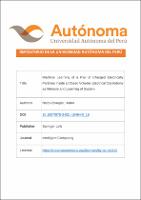| dc.contributor.author | Nieto-Chaupis, Huber | |
| dc.date.accessioned | 2023-10-04T19:35:43Z | |
| dc.date.available | 2023-10-04T19:35:43Z | |
| dc.date.issued | 2022 | |
| dc.identifier.uri | https://hdl.handle.net/20.500.13067/2666 | |
| dc.description.abstract | In this paper the problem of two charged particles inside a frustum is faced through the principles of Machine Learning compacted by the criteria of Tom Mitchell. In essence, the relevant equations from the classical electrodynamics are presented. Once the power is derived, then the systematic errors that might be intrinsic are implemented. Thus, these errors drives the evolution of system inside the frustum in both: experience and learning. In the scenario of electrical oscillations because the repulsion forces, the errors would have oscillatory behavior, fact that is favourable to the system in the sense that acquires memory and improves its learning of measurements done in the past. | es_PE |
| dc.format | application/pdf | es_PE |
| dc.language.iso | eng | es_PE |
| dc.publisher | Springer Link | es_PE |
| dc.rights | info:eu-repo/semantics/restrictedAccess | es_PE |
| dc.rights.uri | https://creativecommons.org/licenses/by-nc-nd/4.0/ | es_PE |
| dc.subject | Machine learning | es_PE |
| dc.subject | Physics | es_PE |
| dc.subject | Nonlinear systems | es_PE |
| dc.title | Machine Learning of a Pair of Charged Electrically Particles Inside a Closed Volume: Electrical Oscillations as Memory and Learning of System | es_PE |
| dc.type | info:eu-repo/semantics/article | es_PE |
| dc.identifier.journal | Intelligent Computing | es_PE |
| dc.identifier.doi | https://doi.org/10.1007/978-3-031-10464-0_16 | |
| dc.subject.ocde | https://purl.org/pe-repo/ocde/ford#2.02.04 | es_PE |


